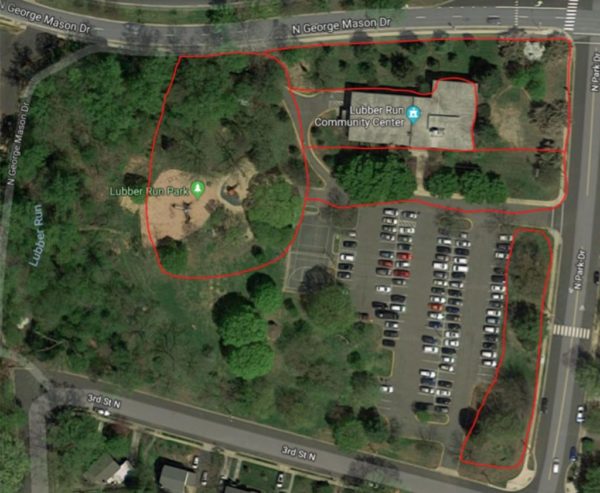 Peter’s Take is a weekly opinion column. The views and opinions expressed in this column are those of the author and do not necessarily reflect the views of ARLnow.com.
Peter’s Take is a weekly opinion column. The views and opinions expressed in this column are those of the author and do not necessarily reflect the views of ARLnow.com.
Two recent columns discussing Arlington’s July 8 countywide flooding and Donaldson Run’s pollution and flood damage explained how the County’s development and construction policies and practices have increased impervious surfaces and resulted in the loss of mature trees. Combined, these factors have almost certainly heightened our flood risk and intensified the damage.
Today, I focus on the July 8 flood impacts on Lubber Run Park.
Lubber Run suffered severe flood damage on July 8
An Arlington resident captured the severe July 8 flood damage to Lubber Run and its park in a series of dramatic videos. This video depicts the destruction of one of the park’s pedestrian bridges, not far from the amphitheater.
Other videos capturing the July 8 flood’s ferocity are here, here, here, and here.
Traveling upstream, the videographer documents the severity of damage to the trail after the flood.
Several factors almost certainly compounded Lubber Run’s intense flooding on July 8.
- Community Center construction: As part of the new Lubber Run Community Center’s construction, the County removed over 100 mature trees. Some of these trees were located on a steep grade and were within Lubber Run’s Chesapeake Bay Resource Protection Area (RPA). Toward the end of 2018, every tree and every other living thing were removed from within the areas outlined in red (see image below) reproduced from Google maps:
- Bridge replacement and sanitary sewer installation: At around the same time, the County replaced and widened the spans of the Carlin Springs bridge crossing George Mason Drive and installed new sanitary sewer infrastructure nearby. Both projects involved soil excavation and land disturbance in or near Lubber Run’s RPA. And the significant land disturbance associated with these projects likely exacerbated the stormwater runoff and flood damage to Lubber Run Park on July 8.
- Ballston Pond “rehabilitation”: Further contributing to July 8’s flood intensity along Lubber Run is the still-incomplete restoration of the Ballston “Beaver” Pond (no beavers are in residence)–a project that has dragged on for years after this stormwater detention pond silted up and could no longer hold and filter large amounts of water. As part of the County’s plans to “retrofit” the pond, many trees and much of the existingvegetation will be removed and the sediment from the pond excavated. Since the pond no longer functions as designed, all the stormwater runoff from 300 urban and suburban acres flows directly downstream into Lubber Run without slowing down to settle out sediment or to filter contaminants from the water.
How the County fails to exercise regulatory powers it already possesses
The Arlington County Board’s repeated claims of powerlessness to take action to protect our environment ring hollow. Here is just one example of those claims.
While it is indeed true that some “rules” on some issues can only be made in Richmond, existing rules often permit adjustments to be made right here in Arlington–but only if County Board members are willing to seize these opportunities.
Stormwater management legislation offers a prime example. Arlington could do a lot more to protect our environment simply by exercising its existing regulatory authority under § 62.1-44.15:33 of the Virginia Code . This section grants Arlington powers to adopt more stringent regulations governing “existing water pollution including nutrient and sediment loadings, stream channel erosion, depleted groundwater resources, or excessive localized flooding within the watershed.”
Conclusion
Development, construction, increases in impervious surfaces, and the ongoing loss of mature tree canopy all exacerbate Arlington’s risk of severe flooding. As further discussed in July’s two columns, Arlington already possesses untapped powers to control each of these contributing factors.
Yet despite the tremendous damage that occurred on July 8, elected officials and staff continue to trot out “Act of God” or “flood of the century” arguments that inspire little confidence in local government.
Had Arlington fully exercised its existing regulatory powers, the damage to Lubber Run Park and other public and private assets almost certainly would have been far less.
Arlington was lucky that no lives were lost on July 8. Next time, there’s no guarantee.
Peter Rousselot previously served as Chair of the Fiscal Affairs Advisory Commission (FAAC) to the Arlington County Board and as Co-Chair of the Advisory Council on Instruction (ACI) to the Arlington School Board. He is also a former Chair of the Arlington County Democratic Committee (ACDC) and a former member of the Central Committee of the Democratic Party of Virginia (DPVA). He currently serves as a board member of the Together Virginia PAC-a political action committee dedicated to identifying, helping and advising Democratic candidates in rural Virginia.
Image via Google Maps


